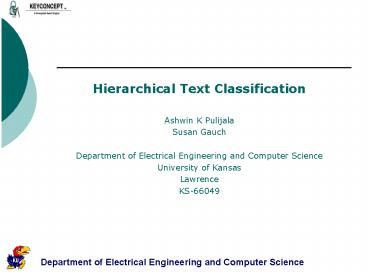Hierarchical Text Classification - PowerPoint PPT Presentation
1 / 24
Title:
Hierarchical Text Classification
Description:
Non-performing classifiers at higher levels lead to poor performance of the ... ODP hierarchy was used as a source of the training data for all the experiments. ... – PowerPoint PPT presentation
Number of Views:270
Avg rating:3.0/5.0
Title: Hierarchical Text Classification
1
- Hierarchical Text Classification
- Ashwin K Pulijala
- Susan Gauch
- Department of Electrical Engineering and Computer
Science - University of Kansas
- Lawrence
- KS-66049
2
Presentation Outline
- Introduction
- Goal
- Text Classification
- Hierarchical Classification Advantages
- Types of Category Structures
- Hierarchical Classification Approaches
- System Architecture
- Experiments and Evaluation
- Conclusion
- Future Work
3
Introduction
- KeyConcept A conceptual search engine.
- Indexes documents using a combination of keyword
and concept. - Retrieves documents based on a combination of
keyword and conceptual matching. - Finds information that is more relevant.
- Classification is automatic but uses a flat
classifier. - Categories are selected from a hierarchical
arrangement of concepts.
4
Goal
- Explore the use of hierarchical structure for
classifying web content. - Construct hierarchical classifiers.
- Compare performance of flat classifier with
hierarchical classifier.
5
Text Classification
- Two Step Process Training the classifier and
classification of new documents - Training Phase
- Classifier is fed with documents that have been
classified manually. - Learns about the features (vocabulary) of the
various categories into which new documents can
be classified.
6
Text Classification contd
- Classification Phase
- Classifier assigns categories to new documents
based on the similarity of the features of input
document and of the categories that it learned
during training.
7
Flat Classification vs. Hierarchical
Classification
8
Hierarchical Classification Advantages
- Increase accuracy by exploiting the relationship
among the categories. - Effectively deal with very large problems.
- Decompose into a smaller set of problems and
solve each problem more accurately by focusing
only on a small set of categories. - Construction of specialized classifiers.
9
Types of Category Structures
- Virtual category tree.
- Category tree.
- Virtual directed acyclic category graph.
- Directed acyclic graph
10
Hierarchical Classification Approaches
- Big bang approach.
- Document is classified using a single step.
- Top-down level based approach.
- Classifiers are built at each level of the
category tree. - Non-performing classifiers at higher levels lead
to poor performance of the lower level
classifiers.
11
System Architecture
12
Text Classification Our Approach ..
- Weight for a given term is given as
- tcij tfij idfi
(1) - idfi Log (Number of documents in D /
- documents in D that contain ti)
(2) - D the collection of super-documents.
- ti ith term in vocabulary.
- dj the jth super-document.
- tfij number of occurrences of ti in dj.
(3) - Normalized Weight
- ntcij (tcij / vector - lengthj)
(4) - where vector - lengthj ? tcij
13
Observations Using a Flat Classifier
- Following observations were made using a flat
classifier - Using 20-40 documents per concept allows reaching
a good compromise between training data and
classifier precision. - Classifier precision is independent of the number
of concepts. - Classifier precision does not depend on the type
of concepts. - Flat classifier has an exact match precision of
around 51.
14
Experiments and Evaluation
- The goal of the experiments was to
- Evaluate and tune the classifiers at each level.
- Determine the optimum number of documents to use
for training the concepts. - Determine the maximum classifier precision at
each level. - ODP hierarchy was used as a source of the
training data for all the experiments. - Test data Randomly-selected level 3 documents.
15
Baseline Setup And Results
- All the concepts from levels 1, 2 and 3 with at
least 20 documents (total 3183 concepts). - 20 randomly selected documents from each concept
used for Training. - 750 randomly selected level-3 documents used for
testing. - Accuracy 48.2 .
16
Experiments and Evaluation
- 1 Classifier at level 1, 15 at level 2, 356 at
level 3. - Documents from parent children (
grandchildren put in the same pool to select). - Parameters we tune Depth and of documents .
17
Experiments and Evaluation
- Trained the classifiers with single document
selected from each class (and subclass) and with
level-4 training data included. - On average, level-1 classes were trained with
approximately 7078 documents, level-2 classifiers
with 7063 and level-3 with 6707. - Same set of documents as used for Baseline was
used for testing.
18
Experiments and Evaluation
19
Experiments and Evaluation
20
Experiments and Evaluation
21
Experiments and Evaluation
- Observations
- 79.5 of documents had an exact match at level 1,
71.3 of documents at level 2 and 70.1 at level
3. - Number of top words to use for categorizing the
documents at each level varied directly with the
number of concepts trained at that level with 3
words used for level 1, 5 words for level 2 and
19 words for level 3. - The exact match precision of the Hierarchical
classifier increased significantly (t-test value
2.56E-06) by 45.4 when compared to Flat
Classifier.
22
Flat Vs Hierarchical Classification
23
Conclusions
- Explored the use of hierarchical structure for
classifying web content. - Built hierarchical classifiers, which increase
the classifier precision by focusing only on a
small set of categories. - Compared the performance of flat classification
with hierarchical classification
24
Future Work
- Classifier precision can be further improved by
- Reducing the number of features needed to
discriminate between the categories within the
same top-level category. - Introducing some recovery mechanism to remedy the
classification errors made early in the
hierarchy. - Selecting documents closest to the centroid for
training instead of random selection.































